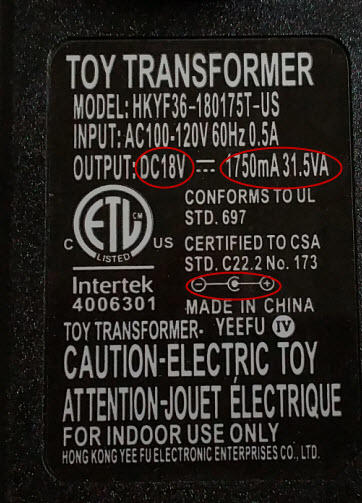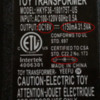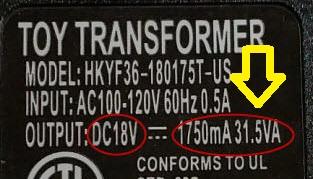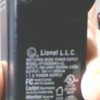I just unpacked a 6-30218, Polar Express, ready to run set. The power pack gives me 39 Volts on the Fastrack by attaching my Volt meter to the center and side rails. I tested the power pack directly by inserting the probe into the end and attaching ground to the outside edge of the plug and it give out 39 Volts. Do I just have a malfunctioning power pack or am I missing something? The engine and tender work great on my Legacy layout at 18 volts. power supply model # YF18020000K3-UL.
Replies sorted oldest to newest
Quizshow904 posted:... am I missing something?
Yes, you are missing something. The train.
Test it again with the train on the track and you will see the real picture... you need to test the output under a load - the open circuit voltage is meaningless.
Rob, you are saying that I should put the train on the track, then plug in the power pack and check the voltage then?? If I am still getting 39 volts, will that not possibly damage the circuit boards in the Polar Express?? Could I try a conventional engine, would that put a "load" on the system??
Putting just about anything electrical on the track should present a load sufficient enough for you to get a "real" voltage reading from the power supply (even a lighted car should be enough). Sounds like it's an unregulated power supply.
The power pack is DC output- be sure to set the meter for DC volts
Put the PE illuminated cars on the track and check with a VOM set to DC.
I'd be a bit cautious. If you are reading 39 volts on the DC scale, something is wrong. I just plugged in a new LC powerpack and measured the voltage right at the connector, no load. It measured 18.5 volts, just what I'd expect. I got no significant reading on the AC scale, not surprising.
Something is wrong there, you should not get 39 volts for an output.
Most people would not check their set but run it first and see what happens. I am surprised that you checked the voltage first before running anything.
Lee Fritz
Confirm you're using the DC mode on your meter. In the AC mode, some hobby-grade meters simply make a DC reading and double it assuming that that the voltage must be alternating + and - and hence be twice the size.
If anyone is curious about their own meter, you can try this at home too! Measure, say, a 9V battery in AC mode and DC mode. Hopefully you'll measure +9V DC and -9V DC (if swapping leads). Some meters will read 18V AC (or so) when measuring the battery in one polarity but 0V AC if you swap the leads. Gold star if you can think through why this happens. ![]()
DC coupled half wave rectifier will give the performance you describe.
It is a shame that small moving-vane meters are so hard to find. Polarity insensitive, can be designed to accurately read AC, DC, AC + DC and true RMS all the while. Actually, there is a clamp-on ammeter intended for utility applications, the Columbia Tong Tester, that works like that. Purely magnetic, no coils or windings or transformers. They also work well in strong electric fields such as you would encounter when clamped around 4.16 kV or 13.8 kV power lines where most electronic and microprocessor designs struggle. Pity they don't make a small version for model train guys. Would remove all doubt...
stan2004 posted:Gold star if you can think through why this happens.
Internal diode? ![]()
The current should be tested under load. The voltage should read/be correct.
The 39 voltage reading just happens to be a little over twice 18 so...I dunno, but I wouldn't put anything on the track without further investigation.
Actually, I'm pretty sure Stan cracked the code, he's using the AC scale and he has a cheap meter. I did the experiment, I finally found an old Harbor Freight meter that would demonstrate the indications he's getting. The LC power supply is actually regulated, so you don't need a load to get an accurate reading. When I measure one with a DC meter, I get 18.5, but when I measure with the cheap meter set on AC, I get 38.5 volts, swap the leads and I get nothing.
He could place an 18-volt bulb on the output. If it lights normally, it's 18 volts. If it flases and blows, there's a power pack problem.
Oops...I was using the AC scale and it double the output. When I switch to the DC scale I get 18.4 volts. Question,,,how would I know it is a DC output?? The label only says 18 V output 2000ma. Obviously I am still learning about electricity...just when I thought I had learned it all>>>![]()
Quizshow904
DC Transformers are rated, 3 volts ,6 volts ,9 volts ,12 volts and 13.8 volts.
AC Transformers are rated,16 volts 18.6 volts
That's the norm.
Good luck, John
The transformer that comes in the Lion Chief set puts out a constant 18V DC, with 1.8 amps maximum.
Our sure about the voltage rating ? I thought it be AC please take picture of your Transformer and post it so we can see what your talking here.
Quizshow904 posted:Question,,,how would I know it is a DC output?? The label only says 18 V output 2000ma.
That's a very good question to which I don't think there's a universal answer.
Here's a similar brick-shaped adapter. It says "AC Adapter" but it has a DC output. It says AC because it plugs into the AC wall outlet. But I'd say half of the time you'll see this kind of adapter referred to as a "DC Adapter" because it puts out DC.
One clue is if it has the symbol on the right with the + and - symbol. This shows the polarity (presumed DC output) of the plug.
I'd guess your brick might at least have the parallel / dashed-line symbol shown where it says OUTPUT:12V. This symbol indicates DC though I can't think of where one learns this. That's as opposed to the squiggly tilde ~ shown above after INPUT. That symbol indicates AC.
This pack then explicitly states OUTPUT: DC at the bottom which yours apparently does not.
Attachments
Ho Manufacture of that transformer ?
It look like dull Transformer AC and DC TYPE.
Here's the actual LC powerpack, it's pretty clear it's a DC supply. Note that it also shows you the polarity of the plug. ![]()
Attachments
Why is that so odd that 18volts times 1750 milliamperes equals 31.5 watts?(volt amps). Watts law.
I think he's asking why it's specified as VA and not watts. ![]()
VA= voltamps. 31.5 is about equal to 30 watts.
VA is the same thing as watts.
In algebra, it means V times A.
gsvoboda posted:VA is the same thing as watts
Buzz, WRONG!
The ratio between the VA and watts is the power factor. Only in a perfect system with only a resistive load will they be equal.
How? VA 31.5 equals 31.5 watts.
Ok, so the suggestions of putting load on the tracks works, but does not explain 38 volts to the meter.
gsvoboda posted:How? VA 31.5 equals 31.5 watts.
Reread my response again. Do you know what the Power Factor is? The Power Factor of an AC electrical power system is defined as the ratio of the real power flowing to the load to the apparent power in the circuit. As I said, only with a perfectly resistive load is the power factor 1.0, with any inductive or capacitive element, the power factor will be less than 1.0, and the VA and watts will not be equal.
gsvoboda posted:Ok, so the suggestions of putting load on the tracks works, but does not explain 38 volts to the meter.
It's due to the fact that you are using a cheap meter and you're using it on AC instead of DC. The method of measuring AC with inexpensive meters results in doubling the indicated voltage if you're reading DC on the AC scale.
Stan explained this quite well some time back in this thread.
It's a Federal requirement that is supposed to more accurately assist the end user in determining the maximum load on a device for safety purposes.
DC voltamps does equal the watts. But, calculate the formula for AC-not always the same.
The end user doesn't know from anything. They just plug in whatever, wherever and complain if it doesn't work.
Gunrunnerjohn,
that makes sense.
george
In another thread I did the homework on this one, and the basic information I found was that in DC watts=VA. In AC, however VA is the maximum watts theoretically possible. This has to do with the way watts are measured in AC devices. for practical terms, the VA rating is typically the output side rating; How much power can the device supply. Where as in the world of our train transformers, devices rates in Watts are giving you the maximum Input side power load.
For those 2 stars, Watts when used as a proper term, is only useful as a precise, real time measurement of power consumed, and really only important in the grand scheme of things in billing you for electricity. Volt-Amps, on the other hand if of greater use, as it denotes what the maximum power provided is on the output side, and is useful in determining what size wire you need, and what sort of protection circuitry is needed. VA as a proper term is a more useful figure almost all of the time.
That said, if you are looking at the same, input or output, side of a device, a maximum rating in VA or watts is interchangeable. VA has just become industry standard because it is a better system that watts to measure output side power availability, and is easier to understand.
JGL
Don't put 39V to your track.
illinoiscentral posted:Don't put 39V to your track.
I say plug it in and let it RIP!
Everyone else who got a LionChief set for Christmas and didn't check it, improperly, with a cheap $4 meter, is out there running their train.
illinoiscentral posted:Don't put 39V to your track.
It's already been pretty well established that the 39V was a measurement error, not the actual powerpack output, there's no issue with his power.
ADCX Rob posted:I say plug it in and let it RIP!
Everyone else who got a LionChief set for Christmas and didn't check it, improperly, with a cheap $4 meter, is out there running their train.
Right on, let's see the smoke! ![]()
![]()
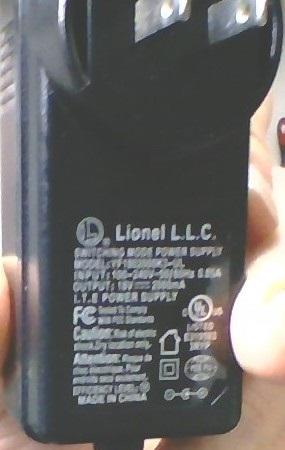 Here is a picture of the power supply...Lionel Chief Polar Express. Sorry it isn't clearer but it says...output 18v 2000ma .85amp. Don't worry the train is already running on the Legacy layout, I am not sure I can hook it up to run on Fastrack using this power supply. The other type of power hookup with Fastrack that just has 2 wires hooks up to my transformer and gets 15 volts just fine on the Fastrack loop.
Here is a picture of the power supply...Lionel Chief Polar Express. Sorry it isn't clearer but it says...output 18v 2000ma .85amp. Don't worry the train is already running on the Legacy layout, I am not sure I can hook it up to run on Fastrack using this power supply. The other type of power hookup with Fastrack that just has 2 wires hooks up to my transformer and gets 15 volts just fine on the Fastrack loop.







